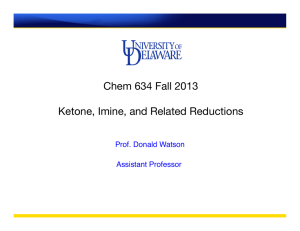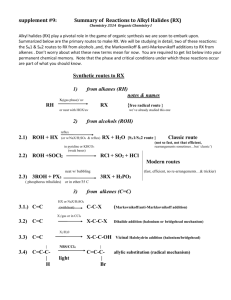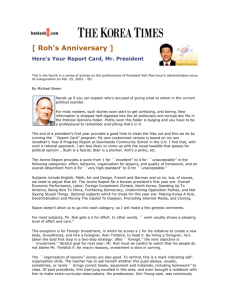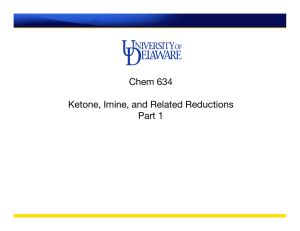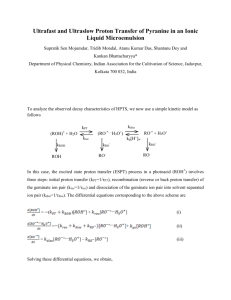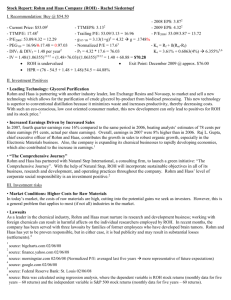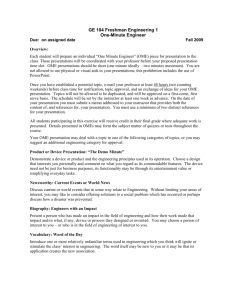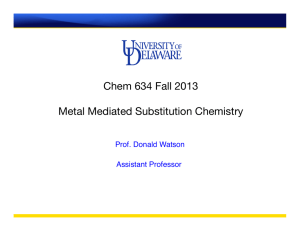Document 10579691
advertisement
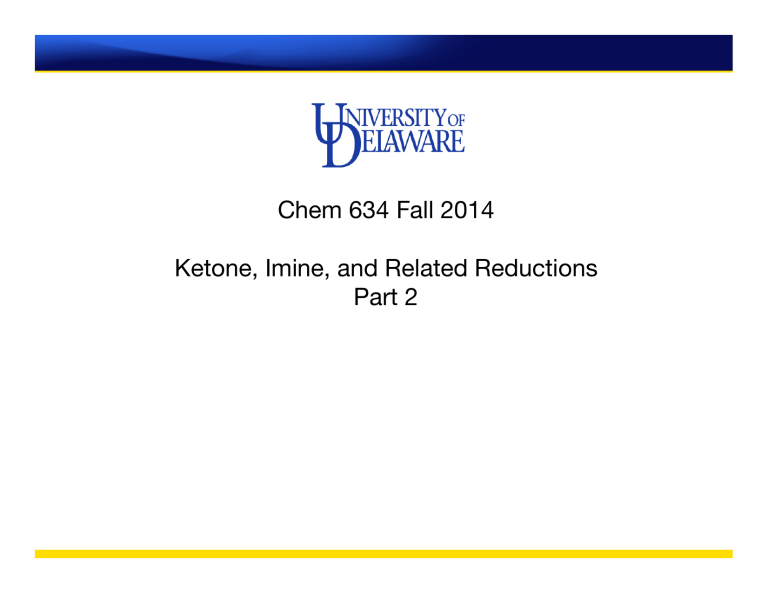
Chem 634 Fall 2014
Ketone, Imine, and Related Reductions
Part 2
Announcements
• Midterms are not yet graded (sorry)
• No office hour tomorrow. Please email if you want an appointment.
• Colloquium on Friday: Joel Rosenthal
Reductant Cheat Sheet
C=X reductants
comment/electophile
iminium ion acid chloride aldehyde/ketone
LiAlH4 (LAH)
Very strong, low solubility in tol
amine
ROH
ROH
NaAlH2(OCH2CH2OMe)2 (Red-Al)
Very strong, soluble
amine
––
ROH
LiAlH(OEt)3
Weaker than LAH
––
––
––
NaAlH(OtBu)3
Weaker yet
amine
slow to ROH
––
NaBH4
Moderate
amine
ROH
ROH
LiBH4
More reactive than Na verison
amine
––
ROH
NaBH(OAc)3
Weaker than NaBH4, more selective
amine
––
slow to ROH
NaCNBH3
even more so
amine
––
slow to ROH
LiBHEt3 (Super-Hydride)
Very strong reductant
––
ROH
ROH
(iBu)2AlH (DIBAL or DIBAL-H)
electrophilic
––
ROH
ROH
BH3•L (L = THF or DMS) or B2H6
electrophilic
––
––
ROH
H2/ cat
hydrogenation
amine
ROH or aldehyde
ROH
–– = not product or not commonly used combination
n/r = no reaction, ROH = alcohol, RHO = aldehyde
ester
amide
carboxylate
ROH
amine
ROH
ROH
amine
ROH
alcohol
RHO (3° amide)
––
slow to ROH slow to amine
––
slow to ROH
n/r
––
ROH
––
slow to ROH
n/r
slow to ROH
––
n/r
n/r
––
ROH
RHO (3° amide)
––
ROH or RHO amine or RHO
ROH
slow to ROH slow to amine
ROH (fast)
ROH
amine
––
nitrile
amine
amine
RHO
––
––
––
––
––
likely red.
RHO
––
amine
Adapted from Carey and Sunburg, 5th Ed.
Diasteroselective Reductions (and Additions)
O
Me
"H-"
H
Me
Me
Me
OH vs
Me
Me
small
OH
Me
H
Me
Me
axial
equat
LAH
92
8
NaBH4
80
20
7
93
Me
Me
very large
3
"L-Selectride"
Me
Me
Me
BHLi
O > 4 kcal/mol
Me MeMe
H
H
favored
H
H
O
Model for Small Reducing Agents: Torsional Strain
O
Me
Me
Me
H
H
O
H
H
H
H
HO
H
H
vs
H
H
δ−
H
torsional motion
results in eclipsing interaction
H
H
H
axial
H
H
O
H
OB
δ−
H
O
No torsional strain
H
equatorial
Favored for
small nucs.
OB
blue arrow = atomic motion of oxygen atom as carbon goes from sp2 to sp3
Model for Large Reductants
R3BH
Me
Me
Me
O
vs
Me
O
Me
Me
R3BH
Need to know how the nucleophiles approach carbonyl.
Burgi-Dunitz Angle
FMO's of C O
π*
π
C O
C O
110°
Approach of Nucleophiles
C
O
Nuc110°
Model for Large Reductants: Developing Diaxial Interactions
R3BH
O
Me
vs
Me
Me
Me
Me
R3B
Me
Me
Me
H H
H
O
Me
R3BH
O
Me
vs
O
Me
Me
R3B
H
favored
developing
1,3 diaxial interactions
OH
Me
H
Me
Me
major
Steric Interactions Can Override
Me
Me
O
Me
Me
H
Me
Me
Me
vs
OH
Me
Me
NaBH4
17
42
83
58
L-select.
0.2
99.8
LAH
all favor equatorial attack
Me
Me
Me
Me
O
H
> 4 kcal/mol
Me
Me
O
OH
H
Similar for Carbon Nucleophiles
Me
O
Me
Me
Nuc
Me
OH
Me
Me
Nuc =
H C C Li
EtMgBr
iPrMgBr
tBuMgBr
88
53
18
0
vs
OH
Me
Nuc
Me
Me
12
47
82
100
Acyclic Stereocontrol in Additions to Carbonyls
O
RL
H
R
HO
Nuc
RL
RM
Nuc
R
RM
HO
or
RL
Nuc
R
RM
More complex as there sigma bond rotation can occur!
O
RL
R
H
RM
Consider case where three substituents at alpha carbon all differ in size.
Felkin - Ahn model
O
RL
R
RM
Assumption: Will add away from largest substituent. Limits problem to
two conformations that much be considered. (Note you MUST get
stereochemistry correct in Newman projections.)
RL
RL
R
O
RM
H
vs
O
R
RM
H
Note these not lowest energy conformers, but most reactive conformers.
Felkin – Ahn Model
RL
RL
R
O
RM
H
vs
O
R
RM
H
RL
Think about FMO’s.
RL
R
O
RM
H
vs
R
O
RM
Nuc—
And Burgi-Dunitz Angle
H
Nuc—
disfavored
favored
Least sterically
demanding approach!
RL
HO
RL
Nuc
R
RM
RL
R
OH
RM
Nuc
H
R
HO
RM
H
Nuc
HO
RL
Nuc
R
RM
favored
Felkin – Ahn Model
Example:
O
Ph
H
H
Me
HO
0 °C
Ph
Me
LAH
74 : 26
L-sel.
99 : 1
Ph
H
Me
Me
Me
Ph
O
H
Me
H
HO
Me
Me
H
H
Note: Ratio (dr) implies favored diastereomer (shown) vs unfavored (not shown). It is very common to only
show one product and assume the reader understands the chemistry well enough to predict the other
product.
Yamamoto JACS, 1998, 110, 4475
Similar for Carbon Nucleophiles
O
Ph
MeLi
Me
Me
–78 °C
HO
Ph
Me
Me
Me
Ohno, JACS 1988, 110, 4826
Cram Chelation Control
O
BOMO
R
Me
H
R
Me
(98 : 2)
Not Felkin!
Me
Me
R
R
Me
–10 °C
Me
O
RO
BOMO
O
BOM =
M
HO
LAH
M
O
O
R
R
H
M
O
O
R
Lewis base
chelates
metal with
carbonyl
R
H
HO
RO
H
Nuc
Nuc
• Lewis basic groups make good chelators.
• Examples: BnO, MeO, BOMO, MOMO, NR2, etc.
Overman TL, 1982, 2355
Reetz, Acc. Chem. Res. 1993, 26, 462
Polar Felkin-Ahn
A values:
O
tBuPh
2SiO
LAH
R
Me
–10 °C
OH
H
tBuPh SiO
2
R
Me 95 : 2
Me = 1.7 kcal/mol
OSiMe3 = 0.74 kcal/mol
H
R' C H
H
Not Chelate!
Note: Silyl ethers are not good Lewis Bases (nO -> σ*Si-C)
R R
Si R
R' O
trans?!?
H
H
O
Me
Arguement: Low lying
OSiR3
OSiR3
H
H
Nuc
σ*C-OSiR3
O
stablizes developing
Me
σ Nuc–C
Nuc
Proposed TS
σ*C-OSiR3
At TS:
σ Nuc–C
σ*C-OSiR3
Occurs with highly electronegative alpha substituents that can not chelate, such
as OSiR3, Cl, F, etc.
Summary of Felkin-Like Models
alpha stereocenter model steric only Felkin-­‐Ahn chela2ng Cram electronega2ve, but non-­‐chela2ng Polar Felkin 1,3 Control
OH O
Syn Reduction:
R
R'
Et
then
workup
Et
-MeOH
R'
Et
Et
H
B
O
R'
OH OH
R
B
OH O
R
Et2BOMe
NaBH4
O
R
O
R'
R
R
O
O
O
R'
R'
Et
B
Et
cyclohexene conformational analysis
H
R
R
H
H
H
H
H
R
Narasaka Chem Lett, 1990, 1415
Model for Diastereoselectivity
"H "
H
R
R'
H
Et
B
O
O
R
Et
Et
B
Et
R
O
O
O
O
R'
R
Et
O
R'
R'
"born into" chair
Et
B
R
Et
H
"H "
OH OH
H
R
Et
H+
B
O
H
Et
B
Et
H
chair-like TS
favored
H
R'
O
O
R'
axial addition
R
H
H
twist-boat-like TS
O
R'
O
Et
B
OH OH
H+
Et
R
H
"born into" twist-boat
disfavored
As carbonyl carbon rehybridizes from sp2 to sp3 it “moves” to meet incoming
nucleophile. Conformational analysis of the TS’s based upon this motion
predict selectivity.
R'
1,3 Control
NaHB(OAc)3
OH O
Anti Reduction:
R
OH OH
R'
R
AcO
NaHB(OAc)3
OH O
R
vs
1,3 diaxial
interaction
worse with
R than O
R'
R'
OAc
Na
B
O
H
O
R
H
OAc
O
R
O B OAc
H
R
favored
then H+
H
OAc
R
R
O B OAc
H
O
disfavored
then H+
R'
H
OH
R
OH
H
R
anti
HR
R
HO
OH
H
syn
Evans JACS, 1988, 110, 3560
Enantioselective Reductions and Additions to C=X
Me
Me B
From:
H
Me
Alpine - hydride (Aldrich)
chiral borohydride
Me
Me
Me
α−pinene (single enantiomer)
Midland Chem Rev. 1989, 89, 1553
DIP-Cl
O
Me
Me
OH
DIP-Cl
R
BCl
R
DIP-Cl
Me
> 98% ee
Cl
Me
B
Me
H
H
Rs
Me
2
R
O
RL
Akin to a chiral DIBAL.
HC Brown (Nobel 1979)
Brown, TL, 1991, 32, 6691
Corey - Bakhi – Shibata (CBS) Catalyst
cat. 1, BH3
O
Ph
H
Me
Ph
N B
Ph
O
Me
H
H
B
H
H
OH
Ph
Me
H Ph
O
N
Ph
O
B
H2B
Me
H
R
Ph
Ph
O
N B
1 Me
H Ph
N
R'
H2B
H
Ph
O
B Me
O
R
R'
Note primarily electronic differentiation between R & R’.
Corey (Nobel 1990)
Corey JACS, 1987, 109, 7925
Functionalized Ketone Hydrogenation Using Ruthenium Catalysts
Hydrogenation of α-ketoesters:
OH
O
OMe
O
Me
OMe
RuCl2(S-BINAP)
100 atm H2
Me
O
93% ee
• Note: This is NOT a simple isolated ketone.
PPh2
PPh2
Noyori (Nobel 2001)
Noyori
β-Ketoester Hydrogenation
O
Me
O
O
OH O
[RuCl2(R-BINAP)]2
OMe
Me
100 atm H2
O
OMe
OH O
OMe
[NH2Me2][{RuCl[(S)-SEGPHOS]}2(m-Cl)3]
OMe
30 atm H2
98% ee
O
PPh2
PPh2
O
O
PPh2
PPh2
O
BINAP
Noyori (Nobel 2001)
SEGPHOS
Noyori JACS 1987, 109, 5856.
Substrate Acts As A Chelate Ligand
Cl
P
*
Ru
P
Solv
Solv
Cl
–H+
Cl
H+
P
*
H2
+H2
Ru
P
O
Solv
R
Solv
OMe
H
Cl
Cl
P
*
Ru
P
OH
P
Solv
*
Solv
H
Cl
O
P
OMe
Ru
P
H
*
R
O
*
P
Ru
OMe
O
O *
H
R
OMe
O
O
R
Substituted β-Ketoester Hydrogenation
O
OH O
O
OMe
NH2•HCl
[RuCl2(R-BINAP)]2(DMF)n
OMe
NH2•HCl
30 atm H2
96% ee, 95% de
O
OH O
O
OMe
[RuCl2(R-BINAP)]2(C6H6)
OMe
100 atm H2
93% ee, 98% de
• Why does this work so well?
O
O
R
OH O
OMe
R'
R
OMe
R'
Dynamic Kinetic Resolution
Other Related Chelating Substrates
β-Aminoketones:
OH
[RuCl2(S-BINAP)](cymene)
O
NMe2
Me
105 atm H2
Me
NMe2
99.4% ee
β-Diketones:
O
Me
O
OH OH
[RuCl2(R-BINAP)]2(C6H6)
Me
100 atm H2
Me
Me
>99% ee and de
Note: These substrates doubly reduced to the trans diol.
Dialkyl Zinc Additions
Me
Me
NMe2
O
Ph
H
aldehydes
only
Me
OH
Me
ZnEt2
HO
Ph
Et
H
98%, 99%ee
Me
Me
N Me
Zn Et
Me
O
O
H
Zn Et
H
• Many chiral amino alcohols work.
• Specific to R2Zn.
Ph
Et
Noyori JACS 1986, 108, 6071
Review: Evans Science 1988, 240, 420
Cyanohydrin Formation
cat.
O
P
Ph2
O
Cl Al
O
Ph2
P
O
O
+
Ph
H
TMSO CN
TMSCN
Ph
H
97%, 97% ee
allyl, vinyl, alkyl
Lewis
Base
Activation
Bifunctional Catalyst:
P O
Al
Lewis
Acid
Activation
SiMe3
CN
H
O
R
Shibasaki JACS, 1999, 121, 2641
Asymmetric Alkyne Addition
OH
O
H
H
cat Zn(OTf)2, Et3N
96%ee
cat.
Ph
Me
HO
NMe2
Carreira JACS 2001, 123, 9687
Chiral Amine Synthesis Using Ellman Auxiliary
O
O
O
R
H2N
H
S
N
tBu
CuSO4
R
S
O
O
tBu
H2N
H
S
=
H2N
tBu
S
tBu
O
O
N
R
S
H
R'MgBr
HN
tBu
R' = Ph, Me, Et, iPr, etc
R
S
tBu
R'
H
NH2
R
R'
>90% dr
RS
Me
S N
RL
M
R'
O
Me Me
Ellman ACR, 2003, 35, 984
Catalytic Asymmetric Additions to Imines
N
Ph
Ts
ArB(OH)2
3% Rh(acac)(coe)2
K3PO4
Ph
20%
Ph2P
HN
Ph
Ts
Ar
94%
95% ee
N
PPh2
Similar reactions with nucleophiles bases on Zn, Sn, Ti, etc
Ellman, ACIE, 2008, 47, 5623
Reductions of α,β-Unsaturated Systems
R
OR
DIBAL
R
OH
O
R
R'
O
cis/ trans
NaBH4
R
CeCl3
Luche Reduction
(w/o CeCl3 1,4 reduction competative)
R'
OH
Catalytic Hydrogenation
R
R'
O
cis or trans
H2
Pd/C
R
R'
O
Note: hydrogenation of trans and/or electron deficient alkenes can be
slow
Dissolving Metal Reductions
O
Na or Li
NH3
O
-33 °C
then H+
Mech
O
M(0)
O M
O M
NH3
-NH2–
O
M(0)
H
O M
H
H2O/ H
O
H
H
Stryker Reagent
O
O
[PPh3 CuH]
H
then H
H
also acyclic
O
O
"H–"
[Cu]
H
Stryker JACS, 1988, 110, 291
Asymmetric Stryker Reaction
O
n
cat. CuCl
cat. (ptol)-Binap
R
n = 1-3
PHMS =
PHMS
O
R
H
up to 98%ee
n
Me
O Si O
H
N
Limited to cyclic enones for good ee.
Buchwald JACS, 2000, 122, 6787
Conjugate Addition of Cuperates
O
R2CuLi
O
R
Review see C&SB 8.1/ 8.7
Asymmetric Version
O
Et2Zn
cat. Cu(OTf)2/ L
O
Et
>98% ee
L=
Ph
O
P N
O
Ph
Me
Me
Feringa ACIE 1997, 36, 2620
Asymmetric Addition of Boronates
R
R'
O
Ar B(OH)2
cat. Rh(I)/BINAP
R
R'
Ar
O
also vinyl
Hayashi Chem Rev, 2003, 103, 2829
Radical Reductions
Barton McCombie Deoxygenation
AIBN =
S
R OH
R O
Bu3SnH
AIBN
R'
NC
R H
Me
(thioxoester)
CN
N N
Me
Me
Me
Azobisisobutyronitrile
Typical Conditions:
R
OH
S
NaH, CS2, MeI
R O
SMe
S
Cl
R
OPh
S
OH
R O
Barton: Nobel 1969
OPh
Barton Perkin Trans I, 1975, 1574
Barton McCombie Mechanism
Radical Initiation:
NC
Me
N N
Me
CN
CN
N N
Me
Me
Me
Me
CN
+
Me
Me
2
Me
Note: AIBN breaks down in two steps, not one.
Bu3Sn
H
+ Me2CCN
Bu3Sn
+ Me2CHCN
Hydrogen atom abstraction
CN
Me
+
N2
Barton Decarbonylation
S
N
O
O
OH
R
OH Std coupling
reagent
R
O
Bu3SnH
N
R H
AIBN
S
Mech:
O
R
O
O
N
R
S
Bu3Sn
O
R
N
S
SnBu3
+
O
C
O
+
N
S
SnBu3
Barton Chem Commun. 1983, 939
Radical Dehalogenation
Bu3SnH
AIBN
R
R'
X
R
R'
H
I > Br > Cl
3° > 2° >> 1°
(radical stability)
Also SmI2 can be used here
(Kagan JACS, 1980, 102, 2693)
Barton McCombie Mechanism
Radical Chain:
R
R
R
Bu3Sn
Bu3Sn
+
Bu3Sn
O
R'
S
R'
+ O
R
R
S
Bu3Sn
R'
O
R'
O
S
S
R3Sn
R H + Bu3Sn
H
R'
O
R
Bu3Sn
R
R'
+ O
S
S
R3Sn
Misc. Alkyl Halide Reduction and Related
OTs
H
LiEt3BH
R X
X = I > Br
+
H2
Pd/ C
80%
20%
SN2
E2
R H
SmI2 Reduction of Ketones
SmI2
O
HO
H
H2O
CO2Et
CO2Et
SmI2
H
O
H2O
HO
SmI2
O
H
+ Sm(III)
CO2Et
+ Sm(III)
Chem Rev 1992, 92, 29
